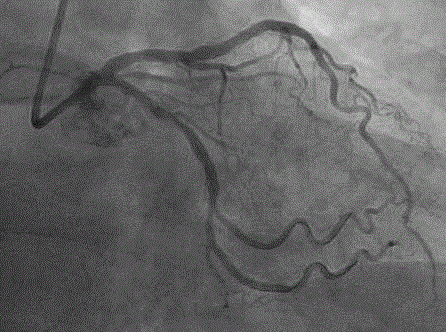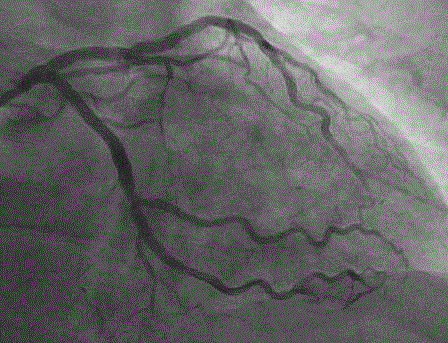Case Report
Use of Dedicated Bifurcation Drug Eluting Stent BioSS® in Coronary Bifurcation Stenosis: Case Report
Pavel Ermolaev* and Kristina Geynts
Department of Endovascular Surgery, Omsk Regional Clinical Hospital, Оmsk, Russia
*Corresponding author: Pavel Ermolaev, Department of Endovascular Surgery, Omsk Regional Clinical Hospital, Оmsk, Russia
Published: 29 Mar, 2018
Cite this article as: Ermolaev P, Geynts K. Use of
Dedicated Bifurcation Drug Eluting
Stent BioSS® in Coronary Bifurcation
Stenosis: Case Report. Clin Surg. 2018;
3: 1948.
Abstract
This case illustrates easy technique of bifurcation coronary lesion treatment with use of dedicated
bifurcation drug eluting stent BioSS®.
Keywords: Percutaneous coronary intervention; Bifurcation stenosis
Introduction
The frequency of coronary bifurcation lesions reaches 15% to 20% in the structure of percutaneous coronary interventions [1]. The anatomical and physiological features of coronary bifurcations are associated with different angles diameters of its constituent branches, turbulent blood flow in the region of the carina, an inhomogeneous distribution of the endothelial shear stress, which determines the complexity and diversity of these types of stenosis. Various methods of endovascular interventions for bifurcation stenosis have proposed with use of common coronary stents and specialized devices [2].
Case Presentation
A 68-year-old man with hypertension and dyslipidemia was referred to our center because
of a 5-year history of chronic angina on effort. Results of an exercise stress test were positive for
chest pain and ischemic electrocardiographic changes. Coronary angiography showed a prolonged
stenosis in proximal segment of circumflex branch of the left coronary artery and true bifurcation
lesion in circumflex and marginal arteries 1.1.1 by Medina A et al. [3] classification (Figure 1).
A percutaneous coronary intervention was performed under local anesthesia. The left coronary
artery was cannulated by Judkins Left 6F guiding catheter via right transradial approach. Two light
polymer coronary guidewires were passed in distal segment of circumflex and marginal arteries.
After balloon dilatation a dedicated bifurcation drug eluting stent BiOSS® (Balton, Poland) was
implanted in area of bifurcation and regular stent was implanted proximally. Figure 2 shows the
final result of percutaneous coronary intervention and restoration of a lumen. The patient was
discharged and at the 6-month clinical follow-up, the patient was asymptomatic.
Discussion
An important aspect of bifurcation interventions is the patency of the lateral branch, which is in risk of occlusion after carina plague shift. Due to the special design of the balloon delivery system and the stent BiOSS® (Balton, Poland), which reproduces the geometric parameters of coronary bifurcation, the patency of the lateral branch was preserved very simple without kissing balloons and proximal optimization technique [4-6]. The BiOSS® (Bifurcation Optimization Stent System) Clinical Programme began in 2008. The first-in-man study was made by Robert J. Gil et al. [5].
Figure 1
Figure 2
Acknowledgement
The authors thank Prof. Robert J. Gil and multidisciplinary team Omsk Regional Clinical Hospital for successful intervention.
References
- Latib A, Colombo A, Sangiorgi GM. Bifurcation stenting: current strategies and new devices. Heart. 2009;95(6):495-504.
- Lassen JF, Holm NR, Stankovic G, Lefevre T, Chieffo A, Hildick-smith D, et al. Percutaneous coronary intervention for coronary bifurcation disease: consensus from the first 10 years of the European Bifurcation Club meetings. Euro Intervention. 2014;10(5):545-60.
- Medina A, Suarez de Lezo J, Pan M. A new classification of coronary bifurcation lesions. Rev Esp cardiol. 2006;59(2):183.
- Bil J, Gil RJ, Vassilev D. BiOSS® Clinical Programme – State of the Art – BiOSS LIM® Stent – The Novel Option for Coronary Bifurcation Treatment. Interv Cardiol Review. 2015;10(2).
- Gil RJ, Bil J, Vassiliev D, Inigo Garcia LA. First-in-Man Study of Dedicated Bifurcation Sirolimus-eluting Stent: 12-month Results of BiOSS LIM® Registry. J Interv Cardiol. 2015;28(1):51-60.
- Gil RJ, Bil J, Vassilev D. The BiOSS stent. Euro Intervention. 2015;11:V153-4.


